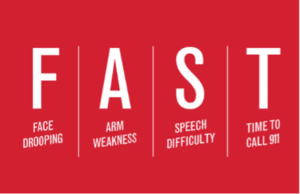June 22, 2023
M&D Clinical Corner: Community Pharmacist’s Guide to Stroke Awareness
The Clinical Corner is a monthly feature that highlights a variety of important pharmacist topics that is written by Morris & Dickson’s staff pharmacist, Paula Belle (RPh).
This month’s Clinical Corner will provide an overview of strokes including:
- Facts and figures
- The pharmacist’s role
- Stroke types
- Signs and symptoms
- Fixed risk factors
- Modifiable risk factors
- Stroke prevention
- Stroke treatment
- Stroke rehabilitation
- Resources for pharmacists
- Resources for patients
Facts and Figures
- Stroke happens when the blood supply to part of the brain is cut off. [1]
- Without blood, brain cells can be damaged or die. [1]
- The impact of stroke can be short- or long-term, depending on which part of the brain is affected and how quickly it is treated. [1]
- Stroke survivors can experience wide-ranging disabilities including difficulties with mobility and speech, as well as how they think and feel. [1]
- In the United States, more than 795,000 people experience stroke every year, and someone dies of stroke every 3.5 minutes.[2]
- Every 40 seconds, someone in the United States has a stroke.[2]
- Stroke reduces mobility in more than half of stroke survivors age 65 and older and is a leading cause of serious long-term disability. [2]
- Stroke-related costs in the United States came to nearly $53 billion between 2017 and 2018. [2]
The Pharmacist’s Role
- Community pharmacists can assist current and potential stroke patients with medication reconciliation, secondary stroke prevention, risk reduction, patient counseling and education, and transitions of care initiatives. [3]
- Many patients with stroke experience difficulty swallowing as one of their major presenting symptoms. [3]
- These patients require nutritional support and medication administration via tubes. [3]
- Pharmacist can offer assistance by educating patients as to which medications can be crushed and which may interact with tube feedings. [3]
- Pharmacists can take a more active role in post-stroke care and initiate prompt follow-up to ensure the highest degree of adherence with secondary prevention within 30 days of hospital discharge. [4]
- These follow-up interventions include:
- Managing high-risk uncontrolled disease states, [4] including high blood pressure, high cholesterol, diabetes and others. [3]
- Providing medication management. [4]
- Smoking cessation education. [4]
- Addressing medication access issues. [4]
- These interventions may lead to improved outcomes, such as [4]:
- Decreased hospital readmissions for recurrent stroke.
- Decreased myocardial infarction, and peripheral arterial disease.
- Improvement in clinical surrogate markers, such as blood pressure, hemoglobin A1c, smoking status, and low-density lipoprotein.
Stroke Types
- There are two main types of stroke: ischemic and hemorrhagic. [5]
Ischemic Stroke
- When a blood clot or any other particle or plaque deposit blocks a blood vessel in the brain, ischemic stroke occurs. [5]
- About 87% of all strokes in the United States are ischemic strokes. [2]
- A transient ischemic attack (TIA) occurs when blood flow to part of the brain is blocked, often by a clot, which then dissipates after a short time alleviating stroke symptoms. [6]
- Any stroke damage from a TIA is typically temporary or confined to a very small region, but TIA is an important sign that a larger, more serious stroke could occur. [6]
Hemorrhagic Stroke
- When any artery in the brain is ruptured and leaks blood, a lot of pressure is put on the brain cells causing damage to them. [5]
- High blood pressure and balloon-like bulges in an artery cause a hemorrhagic stroke. [5]
Signs and Symptoms of a Stroke

Source: American Stroke Association
- Knowing the warning signs and symptoms of stroke can facilitate fast action if someone might be having a stroke. [2]
- The chances of survival are greater when emergency treatment begins quickly. [2]
- In one survey, most respondents (93%) recognized sudden numbness on one side as a symptom of stroke. Only 38% were aware of all major symptoms and knew to call 9-1-1 when someone was having a stroke. [2]
- Patients who arrive at the emergency room within 3 hours of their first symptoms often have less disability 3 months after a stroke than those who received delayed care. [2]
- Signs and symptoms of stroke may include:
- Sudden numbness or weakness in the face, arm, or leg, especially on one side of the body. [7]
- Sudden trouble seeing in one or both eyes. [7]
- Sudden trouble walking, dizziness, loss of balance, or lack of coordination. [7]
- Sudden severe headache with no known cause. [7]
- If stroke symptoms go away after a few minutes, the individual may have had transient ischemic attack (TIA), also sometimes called a “mini-stroke.” [7]
- Although brief, a TIA is a sign of a serious condition that will not go away without medical help. [7]
- The risk of stroke within 90 days of a transient ischemic attack (TIA) may be as high as 17%, with the greatest risk during the first week. [8]
- Unfortunately, because TIAs clear up, many people ignore them. [7]
- Paying attention to a TIA can save a life and should be reported to the individual’s healthcare provider or team right away. [7]
Fixed Risk Factors
Race and Ethnicity
- The risk of having a stroke varies with race and ethnicity. [2]
- In the United States, stroke occurs more often in African American, Alaska Native, American Indian, and Hispanic adults than in white adults.[9]
Age
- Stroke risk increases with age, but strokes can—and do—occur at any age. [2]
- In 2014, 38% of people hospitalized for stroke were less than 65 years old. [2]
Gender
- At younger ages, men are more likely than women to have a stroke. [9]
- But women tend to live longer, so their lifetime risk of having a stroke is higher. [9]
- Women who take birth control pills or use hormone replacement therapy are at higher risk. [9]
- Women are also at higher risk during pregnancy and in the weeks after giving birth. [9]
- High blood pressure during pregnancy — such as from preeclampsia — raises the risk of stroke later in life. [9]
Family History
- The risk of having a stroke is higher if a parent or other family member has had a stroke, particularly at a younger age. [9]
- Certain genes affect stroke risk, including those that determine blood type. People with blood type AB (which is not common) have a higher risk. [9]
Other Non-modifiable Factors
- Brain aneurysms or arteriovenous malformations (AVMs). AVMs are tangles of poorly formed arteries and veins that can break open in the brain and are major risk factors for stroke. [9]
- Viral infections or conditions that cause inflammation, such as lupus or rheumatoid arthritis are also risk factors for stroke. [9]
Modifiable Risk Factors
- High blood pressure, high cholesterol, smoking, obesity, and diabetes are leading causes of stroke. [2] 1 in 3 U.S. adults has at least one of these conditions or habits. [2]
- Anxiety, depression, and high stress levels, as well as working long hours and not having much contact with friends, family, or others outside the home are considered risk factors for stroke. [9]
- Additional risk factors for stroke include: unhealthy lifestyle habits, including eating unhealthy foods, not getting regular physical activity, drinking alcohol, getting too much sleep (more than 9 hours), and using illegal drugs such as cocaine. [9]
Stroke Preventions
- Patients can help prevent stroke by making healthy choices and controlling any health conditions they may have. [10]
- Eating foods low in saturated fats, trans fat, and cholesterol and high in fiber can help prevent high cholesterol which increases the chance for stroke. [10]
- Limiting salt (sodium) in the diet can also lower blood pressure and stroke risk. [10]
- Regular physical activity will help patients to maintain a healthy weight and lower cholesterol and blood pressure. [10]
- Cigarette smoking greatly increases the chances of having a stroke, so patients who quit smoking will lower their risk for stroke. [10]
- Too much alcohol can increase blood pressure so patients should limit intake to 2 drinks per day for men and 1 drink per day for women. [10]
- Patients diagnosed with high cholesterol should monitor cholesterol levels via regular blood testing and follow any healthcare provider recommendations for diet, lifestyle, or medication changes. [10]
- Patients with hypertension should monitor blood pressure regularly via their own monitor, their physician, or their pharmacies. They should also follow any doctor recommended diet, lifestyle or medication regiments. [10]
- Diabetic or pre-diabetic patients should make every effort to control these conditions by getting blood sugar levels checked regularly and following healthcare provider recommendations for increasing physical activity, and choosing healthy foods. [10]
- Patients with coronary artery disease and irregular heartbeats known as atrial fibrillation should follow all healthcare team recommendations for treatment or surgery. [10]
- All patients who are prescribed medications for heart disease, high cholesterol, high blood pressure, or diabetes should follow the instructions for taking these medications carefully and should not stop medications unless recommended by their healthcare provider, as controlling these health issues can reduce risk of stroke. [10]
- 1 in 4 stroke survivors has another stroke within 5 years. [8]
Stroke Treatment
- Individuals that suspect they or someone else is having a stroke should dial 9-1-1 immediately. [8]
- Calling an ambulance means that medical staff can begin life-saving treatment on the way to the emergency room. [8]
- 1 in 3 stroke patients never calls 9-1-1. [8]
- Brain scans will identify the type of stroke that has occurred. [8]
- If an ischemic stroke victim reaches the hospital within 3 hours of the first symptoms of an ischemic stroke, a thrombolytic (a “clot-busting” drug) may be administered to break up blood clots. Tissue plasminogen activator (tPA) is a thrombolytic. [8]
- tPA improves the chances of recovering from a stroke. [8]
- Studies show that patients with ischemic strokes who receive tPA are more likely to recover fully or have less disability and are also less likely to need long-term care in a nursing home than patients how do not receive tPA. [8]
- For patients who experience hemorrhagic stroke, other medicines, surgery, or procedures may be needed to stop the bleeding and save brain tissue. [8]
- Hemorrhagic stroke procedures may include endovascular procedures to help repair a weak spot or break in a blood vessel, or surgery such as the type performed to insert a metal clip to stop blood loss from a ruptured aneurysm. [8]
Stroke Rehabilitation
- Rehabilitation after a stroke begins in the hospital, often within a day or 2 after the stroke. It helps ease the transition from the hospital to home and can help prevent another stroke. [8]
- Recovery time after a stroke is different for everyone. It can take weeks, months, or even years. Some people recover fully, but others have long-term or lifelong disabilities. [8]
- After a stroke, patients may make great progress in recovery but may also experience problems that linger such as:
- Paralysis, weakness, or both.
- Difficulties with thinking, awareness, attention, learning, judgement, and memory. [8]
- Speech problems such as understanding speech or forming speech. [8]
- Trouble expressing or controlling emotions. [8]
- Pain in the hands and feet. [8]
- Trouble chewing and/or swallowing. [8]
- Problems with bladder or bowel control. [8]
- Depression [8]
- Rehabilitation can include working with speech, physical, and occupational therapists.[8]
Resources for Pharmacists
- American Stroke Association infographic: https://www.stroke.org/en/professionals/stroke-resource-library/post-stroke-care/the-known-and-unknown-of-stroke-infographic .
- Preventing stroke infographic: https://www.heart.org/en/healthy-living/healthy-lifestyle/prevent-heart-disease-infographic .
- Stroke communication kit: https://www.cdc.gov/stroke/communications_kit.htm .
- CDC shareable stroke graphic: https://www.cdc.gov/stroke/communications_kit.htm#sg
- The latest news on stroke https://www.heart.org/en/news/tag-stroke-news .
- The latest news on stroke research: https://www.heart.org/en/news/category-stroke .
- Stroke treatment guidelines and information: https://www.mayoclinic.org/diseases-conditions/stroke/diagnosis-treatment/drc-20350119 .
- Booklets and factsheets for reliable information on stroke-related issues: https://www.uhs.nhs.uk/Media/SUHTInternet/Services/Strokeservices/Stroke-information-booklet.pdf
- American Heart Association Podcast April 4, 2022 : https://www.ahajournals.org/str/podcast
- Cleveland Clinic Podcast April 2, 2022: https://consultqd.clevelandclinic.org/advancements-in-acute-stroke-therapies-podcast/
Resources for Patients
- Intregris Health stroke quiz: https://integrisok.com/resources/articles/stroke-quiz.
- University of Rochester stroke quiz: https://www.urmc.rochester.edu/encyclopedia/content.aspx?contenttypeid=40&contentid=StrokeQuiz2
- Mcleod Health stroke knowledge quiz: https://www.mcleodhealth.org/services/care/stroke/stroke-quiz/
- Patient educational video: https://www.ypo.education/neurology/stroke-t308/video/
- Stroke rehabilitation video : https://careguides-videos.med.umich.edu/channel/Videos+for+Stroke+Survivors/152907671
- Stroke stories of hope: https://www.cirm.ca.gov/our-progress/stories-hope-stroke-0
- Stroke stories podcast: https://www.stroke.org.uk/life-after-stroke/stroke-stories-podcast
- Stroke support resources: https://www.ohsu.edu/brain-institute/stroke-resources-patients-and-families
- Support groups: https://www.stroke.org/en/help-and-support/support-group-leader-resources/finding-support-groups.
Sources
- World Stroke Organization. Learn about stroke. 2023 [cited 2023; Available from: https://www.world-stroke.org/world-stroke-day-campaign/why-stroke-matters/learn-about-stroke.
- Centers for Disease Control and Prevention. Stroke Facts | cdc.gov. 2022 2022-12-07T10:59:27Z [cited 2023; Available from: https://www.cdc.gov/stroke/facts.htm .
- Appold, K. Integrating Pharmacists Into Stroke Care Teams. 2021 May 12, 2021 [cited 2023; Available from: https://cdn.sanity.io/files/0vv8moc6/drugtopics/bcdc58a1d6fea0ae44bbd4d63c4b98eb8be387a4.pdf/DRTP0521_Ezine.pdf
- Harris, J.L., et al., Pharmacists Act on Care Transitions in Stroke (PACT-Stroke): A Systems Approach. Clinical Therapeutics, 2022. 44(3): p. 466-472.
- Centers for Disease Control and Prevention. About Stroke | cdc.gov. 2022 2022-12-07T11:00:42Z [cited 2023; Available from: https://www.cdc.gov/stroke/about.htm
- National Institute of Neurological Disorders and Stroke. Transient Ischemic Attack (TIA). 2023; Available from: https://www.ninds.nih.gov/health-information/disorders/transient-ischemic-attack-tia?search-term=transient
- Centers for Disease Control and Prevention. Stroke Signs and Symptoms | cdc.gov. 2023 2023-01-30T04:32:02Z [cited 2023; Available from: https://www.cdc.gov/stroke/signs_symptoms.htm
- Centers for Disease Control and Prevention. Treat and Recover from Stroke | cdc.gov. 2022 2022-12-07T10:52:48Z [cited 2023; Available from: https://www.cdc.gov/stroke/treatments.htm
- National Heart, L., and Blood Institute,. Stroke: Causes and Risk Factors. 2023 [cited 2023; Available from: https://www.nhlbi.nih.gov/health/stroke/causes#:~:text=The%20major%20risk%20factors%20for,disease%2C%20and%20carotid%20artery%20disease.
- Centers for Disease Control and Prevention. Prevent Stroke: What You Can Do | cdc.gov. 2022 2022-12-07T10:49:15Z [cited 2023; Available from: https://www.cdc.gov/stroke/prevention.htm



